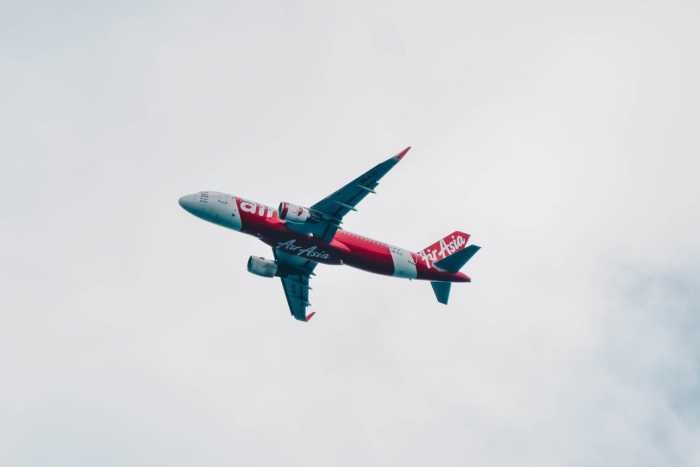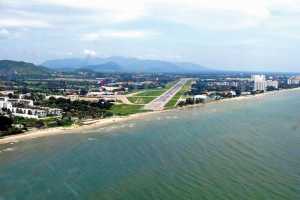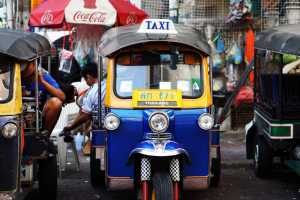
Airline Industry Characters - Richard Branson and Tony Fernandos.
13th Sep 2010

Phuket is served by two airlines, V-Australia and AirAsia that are owned by a flamboyant billionaire, Sir Richard Branson (Virgin) and an equally colourful multi-millionaire, Tony Fernandos (AirAsia)who are part of a long line of brilliant aviation businessmen.
Sir Richard's Virgin Group has a stake in V-Australia through Virgin Blue, the low cost Australian based carrier, which is now that country's second largest airline. In December 2009 V Australia started once weekly flights between Melbourne and Phuket and twice weekly between Brisbane and Phuket.
Tony Fernandos turned Kuala Lumpur based AirAsia, a failed government linked Malaysia airline, into arguably the world's fastest growing and most successful low cost airline. Phuket is now the second hub, to the main Kuala Lumpur base, for AirAisa. The group travels to more than 20 countries and continues to expand both short and long haul low cost routes.
Sir Richard is worth around Pounds 2.6 billion (1.27 trillion baht) and Tony Fernandos is worth around USD230 million (7.36 billion baht) Both now sponsor Formula One motor racing teams, the Virgin F1 Team and the Lotus F1 Team.
It was apparent from the time he founded AirAsia in 2001 Fernandos modeled development of his airline on Sir Richard's flamboyant celebrity publicity seeking model, which relied heavily on the personal public relations commitment of the founder to keep the company in the public eye.
Consequently, both men were frequently photographed surrounded by beautiful flight attendants celebrating the opening of a new route or delivery of new aircraft. In Sir Richard's case it also involved undertaking highly publicized, but dangerous, stunts like flying hot air balloons around the world ( attempted but failed ) driving a high powered jet boat across the Atlantic, coming down in a balloon in the middle of the Canadian wilderness, sparking genuine fears for his life and even setting the fastest crossing of the English Channel in an amphibious vehicle in 2004.
But the public relations has only been one part of their success. Clearly both are risk taking, canny businessmen who know their markets well. The Virgin group is into everything from its famous superstores, to the airline group of companies to owning a railway company Britain.
Fernandos has stuck to his knitting of the airlines, although, in a not so strange twist, he cut his business teeth working for Richard Branson's Virgin Records as financial controller in London from 1987-89. He also worked for Virgin Atlantic, Sir Richard's first airline venture, as an auditor, so he clearly knew a lot about the Branson modus operandi before taking the plunge with AirAsia.
And they, in turn, looked to great aviation pioneers for their own inspiration. In Sir Richard's case it was clearly Sir Freddie Laker, a British entrepreneur who founded Laker Airways in 1966, the first airline to adopt the 'no frills' airline business model which has become the norm today. After going bankrupt Sir Freddie launched Skytrain in 1971, the first daily trans-Atlantic, low fare scheduled service between London and new York, charging Pounds59 one way from London and Pounds135 one way from New York. The airline made its last flight before bankruptcy in 1982.
But the visionary Sir Freddie had seen the way ahead for low cost carriers.
Southwest Airlines, headed by Herb Kelleher, of the United States began as the only budget carrier of its day in 1971 and continues to prosper to this day. Southwest commenced service with three airplanes in 1971 and today operates a fleet of more than 530 airplanes performing over 3100 flights per day. Kelleher's Company has been profitable for 37 consecutive years and has never laid of an employee
Others to follow much later were Ryanair of Ireland, headed by another larger-than-life airline celebrity in Michael O'Leary and easyJet, founded by the equally outrageous Sir Stelios Haji-Ioannou, who also established a set of multiple "easyJet" branded business in the Virgin mold.
Ironically O'Leary and Sir Stelios in July settled a court case in which Ryanair paid Pounds 50,100 in libel damages for running a picture of the good Knight with a long Pinochio nose. This resulted from an advertisements Ryanair ran accusing Sir Stilios of suppressing easyJet's on time performance and called on him to "stop hiding the truth."
It was typical of both men to, firstly run such a series of ads, and then for the other to response with legal action. O'Leary has also hit headlines recently by proposing to charge passengers for going to the toilet on Ryanair flights.
All of these great businessmen have one thing in common, apart from running airlines: they saw the potential of the low cost carrier boom and, with many such carriers going out of business in recent years, have managed to stay in business and thrive.
So next time you are on a V Australia or an AirAsia flight flying in or out of Phuket remember the pioneering entrepreneurs who made it all possible. Great business men all of them.









